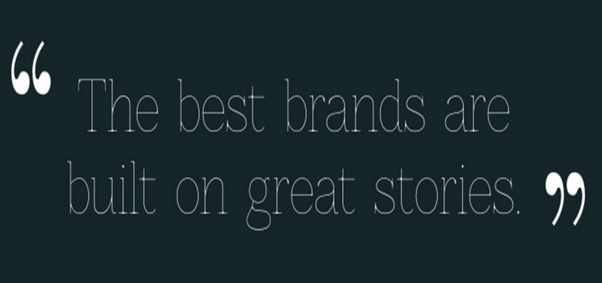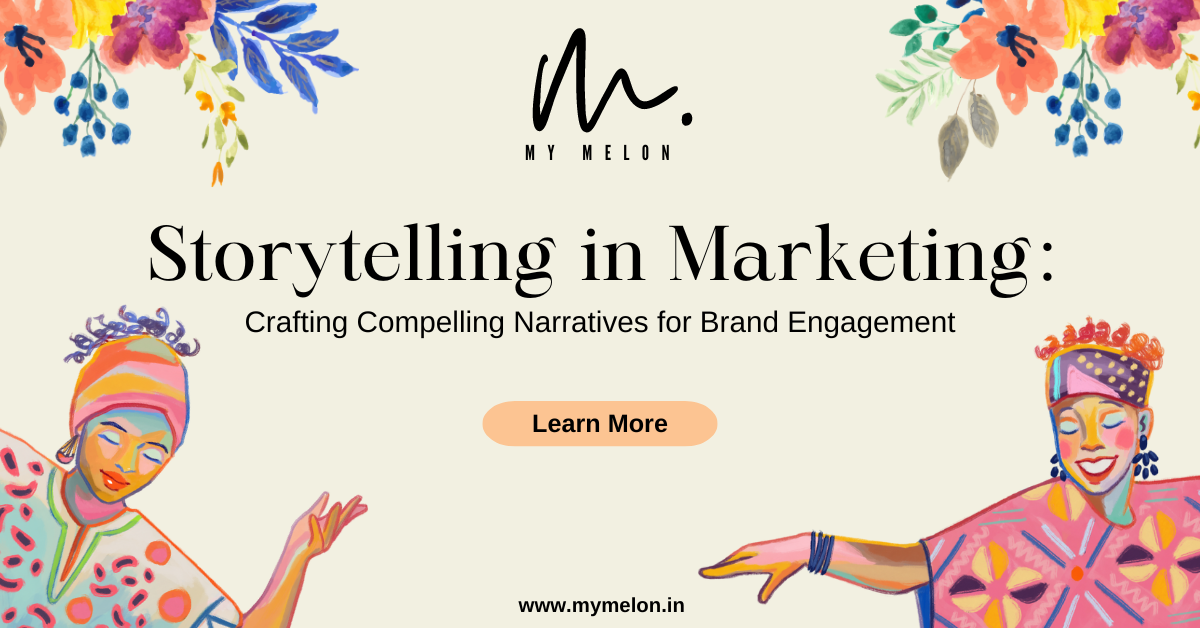Storytelling is a potent force that resonates deep within audiences. It’s like flipping a switch that triggers their imagination, empathy, and sense of connection towards a brand.

When someone is emotionally invested in a story, the brain releases oxytocin often dubbed the “love hormone”… It’s the same chemical that bonds mothers with their babies and strengthens social connections. This surge of oxytocin when a person hears a brand’s story creates a profound effect, it’s not just a story anymore—it’s a bond forming between them and the brand.
In marketing, this connection is priceless. It transforms a brand from a faceless entity to a trusted companion on the consumer’s journey. It’s the difference between a fleeting interaction and a lasting relationship. By leveraging the power of storytelling, brands can create experiences that linger in the hearts and minds of their audience, ultimately fostering loyalty & advocacy.
Why Storytelling Is Essential for Brands
Brand Identity
Stories help define and reinforce a brand’s identity. They can communicate the brand’s values, mission, and personality, helping to differentiate it from competitors.
Engaging Content
Stories are inherently engaging and can capture the audience’s attention more effectively than traditional marketing messages. They can draw people in, encourage them to spend more time with the brand and increase brand recall.
Memorable Impact

It is more memorable than facts or statistics, helping the audience remember key messages and information about the brand long after they’ve encountered the story.
Building Loyalty
By telling stories that resonate with their audience, brands can build loyalty and affinity. People are more likely to support brands that they feel a connection to, and storytelling is a powerful way to create that connection.
Emotional Appeal
The story isn’t what matters… it’s what the story creates that matters: EMOTION, which can drive action. Whether it’s joy, nostalgia, or excitement, emotions can motivate people to engage with the brand.
Creating Shareable Content
Stories that are compelling and relatable are more likely to be shared by audiences. This can help increase brand reach and visibility, as well as generate word-of-mouth recommendations.
Inspiring Action
Ultimately, storytelling is about inspiring action. Whether it’s making a purchase, supporting a cause, or sharing a message, stories have the power to motivate people to take action in support of the brand.
Elements of a Compelling Brand Story
Character
The protagonist in your brand story should be more than just a face, they should embody the values and qualities that your brand stands for. This character could be a customer who has benefited from your product or service, an employee whose journey reflects your company culture, or even the brand itself personified. For example, Apple’s brand story often revolves around the innovative and forward-thinking character of its co-founder, Steve Jobs.
The takeaway here is that a strong character helps humanize your brand, making it more relatable and memorable to your audience.
Plot

A compelling narrative arc keeps the audience engaged and interested in your brand story. For instance, Coca-Cola’s “Share a Coke” campaign created a narrative arc by personalizing their products with individual names. This campaign had a clear beginning (introduction of personalized bottles), middle (consumers finding their names on bottles), and end (sharing a Coke with a friend). This simple yet effective plot engaged customers and encouraged them to participate in the brand story.
Setting

The setting of your brand story provides context and helps the audience visualize the story. Airbnb does this exceptionally well by showcasing unique and beautiful accommodations around the world. Each listing tells a story about the location, the host, and the experience, creating a vivid setting that entices customers to book. This setting allows customers to imagine themselves in these locations, making the brand more aspirational and desirable.
Conflict & Resolution
Conflict is an essential element of any story because it adds drama and tension, making the story more compelling. The conflict in your brand story could be a challenge or obstacle that the character faces, such as a competitive market or a changing industry landscape. The resolution shows how the character overcomes the conflict, often by using your product or service, and how they grow or change as a result.
Storytelling Process

Great stories happen to those who can tell them… and crafting a compelling story is an art.
So, here are the stages of the effective storytelling process –
Know Your Audience… Understanding your audience is fundamental to effective storytelling. Conduct thorough research to identify their demographics, preferences, and pain points. This insight will guide you in creating a story that speaks directly to their needs and interests, increasing its relevance and impact.
Define Your Core Message… Your core message is the heart of your story, conveying the main idea or purpose you want to communicate.
It should be clear, concise, and aligned with your brand values. By defining your core message upfront, you can ensure that every element of your story supports and reinforces it, creating a cohesive and impactful narrative.
Choose Your Story Type… Different stories evoke different emotions and reactions.
Depending on your goals, you may choose to tell a story that inspires action, conveys values, fosters community, or educates your audience. Each type of story requires a unique approach and narrative style to achieve its intended effect.
Establish Your Call-to-Action (CTA)… A strong call to action is essential for guiding your audience toward the desired outcome. Whether you want them to make a purchase, sign up for a newsletter, or participate in a campaign, your CTA should be clear, compelling, and closely tied to your story’s message.
Select Your Story Medium… Consider the preferences and habits of your target audience when selecting a medium. Understanding how your audience consumes content can help you choose the most effective medium for your story.
- Written Stories
Written stories are ideal for conveying detailed information and complex ideas. They allow for precise language and detailed descriptions, making them suitable for conveying intricate narratives or concepts.
- Audio Stories
Audio stories can create a more immersive experience for your audience by allowing you to use sound effects, music, and voice modulation to enhance the storytelling experience. Audio stories are great for creating a sense of intimacy and connection with your audience.
- Visual Stories
Visual stories use images, videos, and animations to convey your message. They can be highly engaging and memorable, making them ideal for storytelling that relies heavily on visuals.
- Combining Mediums
You can also combine different mediums to create a more engaging and dynamic storytelling experience. Use a combination of written content, audio narration, and visual elements to create a multimedia story that appeals to a wider audience.
- Experimenting and Iterating
Don’t be afraid to experiment with different mediums to see what works best for your audience. Use analytics and feedback to understand how your audience responds to different mediums and iterate on your storytelling approach accordingly.
Plan and Structure Your Story… Planning is key to ensuring that your story flows smoothly and effectively communicates your message.
Create a detailed outline or storyboard that outlines the key elements of your story, including the introduction, main body, and conclusion. This will help you organize your thoughts and ideas, making it easier to create a compelling narrative.
Write Your Story… With your plan in place, bring your story to life.
Focus on creating engaging and relatable characters, developing a compelling plot, and using descriptive language to paint a vivid picture for your audience. Use storytelling techniques such as foreshadowing, suspense, and emotional appeal to capture and maintain your audience’s attention.
Share Your Story… Once your story is complete, it’s time to share it with the world.
Use a variety of channels, including social media, email marketing, and content platforms, to reach your audience. Encourage feedback and engagement to create a dialogue around your story and build a deeper connection with your audience.
Track and Analyze Performance… Storytelling is an iterative process, and there is always room for improvement.
Monitor the performance of your story using analytics tools to track metrics such as engagement, click-through rates, and conversions. Use this data to gain insights into what is working well and areas for improvement. Iterate your story based on these insights to continuously refine and enhance its effectiveness.
The 3 “Be’s” for Better Brand Storytelling
- Be Authentic!
Authenticity is key to effective brand storytelling. Be true to your brand’s values, mission, and personality. Authentic stories resonate with audiences and build trust. Practical Tip: Share behind-the-scenes glimpses of your brand to humanize your story and connect with your audience on a personal level.
- Be Relevant!
Tailor your brand stories to resonate with your target audience’s interests, needs, and preferences. Keep abreast of current trends and topics relevant to your industry and audience demographics to ensure your storytelling remains timely and impactful.
- Be Consistent!
Consistency is crucial for building a strong brand identity. Ensure that your storytelling aligns with your overall brand message and is consistent across all channels.
Try to create a style guide for your brand’s storytelling, including tone of voice, imagery guidelines, and key messaging, to maintain consistency across all your storytelling efforts.





